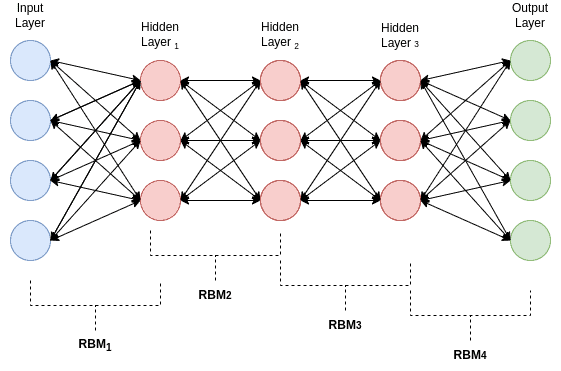1. 引言
在本文中,我们将深入探讨深度信念网络(Deep Belief Network, DBN),它是一种具有深层结构的生成式图模型。我们不仅会介绍DBN的结构,还会回顾其基础组件——玻尔兹曼机(Boltzmann Machine, BM) 和 受限玻尔兹曼机(Restricted Boltzmann Machine, RBM) 的架构,分析它们与普通神经网络的不同之处。
此外,我们还会讨论DBN的训练机制、优缺点以及常见应用场景。本文适合对神经网络有一定了解的开发者或研究人员,旨在帮助你快速掌握DBN的核心思想和使用方式。
2. BM 与 RBM 的架构
2.1. BM(玻尔兹曼机)
BM是一种无监督学习算法,由Geoffrey Hinton和Terry Sejnowski于1983年提出。其名称来源于其使用了玻尔兹曼分布来建模节点间的概率关系。
BM的基本结构包括:
- 一个可见层(visible layer)
- 一个或多个隐藏层(hidden layer)
其中,每一层内部节点之间也存在连接,这使得BM的结构较为复杂。
这种全连接结构使得BM在建模时能捕捉到数据之间的复杂依赖关系,但也导致其训练成本非常高。
2.2. RBM(受限玻尔兹曼机)
RBM是BM的一种简化版本,其关键区别在于:
✅ 层内无连接,即可见层和隐藏层内部节点之间没有连接
✅ 仅存在层间连接
如下图所示,(a) 是 BM,(b) 是 RBM:

其中:
p表示隐藏层节点数d表示可见层节点数
RBM的主要任务是通过学习数据的概率分布来识别模式和提取特征。
- 输入数据(如图像)传入可见层
- 隐藏层通过权重矩阵提取特征
- 权重
连接两层,形成一个权重矩阵
2.3. RBM 的训练过程
RBM的训练过程如下图所示:

训练过程中:
- 每个隐藏节点都加上一个偏置
- 然后通过激活函数进行非线性变换
- 每一层的输出作为下一层的输入
训练目标是不断调整权重,使得网络能够重构可见层和隐藏层的数据。
3. DBN 的架构
DBN由Geoffrey Hinton于2006年提出,其核心思想是将多个RBM堆叠起来,形成一个深层网络。
DBN的结构如下图所示:

关键特点:
- 每两个相邻层构成一个RBM
- 上一层的输出作为下一层的输入
- 权重矩阵连接相邻层,形成中间特征表示
DBN的这种堆叠结构使其能够逐层提取数据的高阶特征,是一种典型的无监督预训练方法。
3.1. DBN 的训练过程
DBN的训练采用一种贪心策略,即:
- 每次训练两个相邻层组成的RBM
- 固定已训练的层,将隐藏层的输出作为下一层RBM的可见层输入
- 重复这个过程直到所有层都训练完成
训练流程总结如下:
- 第一个RBM使用原始输入数据作为可见层
- 训练完成后,生成隐藏层输出
- 该输出作为下一个RBM的可见层继续训练
- 依此类推,直到最后一层
这种逐层训练的方式有效缓解了传统神经网络中的梯度消失问题。
4. 神经网络与 DBN 的差异
| 比较维度 | 神经网络(如CNN) | DBN |
|---|---|---|
| 模型类型 | 判别模型 | 生成模型 |
| 层间连接 | 有向连接 | 无向连接 |
| 训练方式 | 反向传播 | 逐层RBM训练 |
| 特征提取 | 通过权重学习 | 通过概率分布学习 |
| 应用场景 | 分类、检测等 | 特征提取、数据生成等 |
✅ DBN的优势在于其无监督预训练机制,适用于数据标注不足的场景。
❌ 缺点是训练成本高、收敛慢,在实际工程中不如CNN流行。
5. DBN 的优缺点
优点:
- ✅ 能处理多种类型的数据(图像、文本、音频等)
- ✅ 通过隐藏层提取数据中的潜在特征
- ✅ 适合无监督学习场景,具备生成能力
缺点:
- ❌ 训练耗时,计算资源需求高
- ❌ 对数据量要求大,小数据集上表现不佳
- ❌ 在现代深度学习中逐渐被CNN、Transformer等结构取代
⚠️ 注意:DBN虽然理论优美,但在实际项目中使用较少,更多是作为理解生成模型的基础。
6. RBM 与 DBN 的应用
RBM 的常见用途:
- ✅ 特征学习
- ✅ 数据降维
- ✅ 分类与回归任务
- ✅ 生成合成数据(用于数据增强)
DBN 的常见用途:
- ✅ 图像分类(Image Classification)
- ✅ 目标检测(Object Detection)
- ✅ 语义分割(Semantic Segmentation)
- ✅ 实例分割(Instance Segmentation)
实际应用案例:
- ✅ 自动驾驶中的图像识别
- ✅ 医疗影像分析
- ✅ 卫星图像处理
- ✅ 人脸识别系统
7. 小结
在本文中,我们详细介绍了:
- ✅ BM 的结构与局限性
- ✅ RBM 的结构、训练流程与核心思想
- ✅ DBN 的堆叠结构及其训练方式
- ✅ DBN 与 CNN 的主要差异
- ✅ DBN 的优缺点及典型应用场景
虽然DBN在现代深度学习中已不常用,但其逐层预训练的思想对后来的深度学习发展产生了深远影响。对于希望理解生成模型、无监督学习机制的开发者来说,DBN依然是一个值得研究的经典模型。